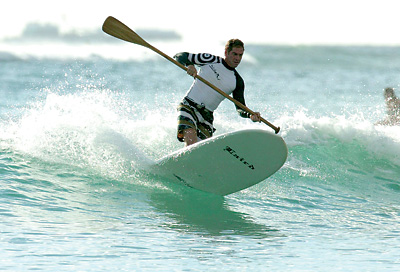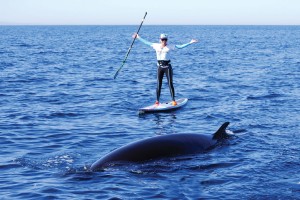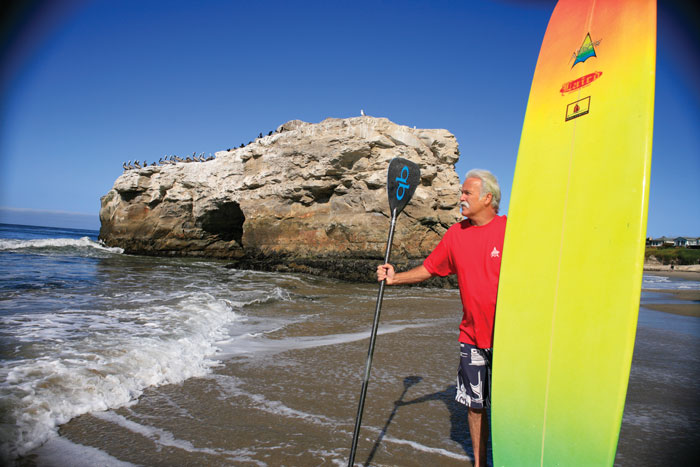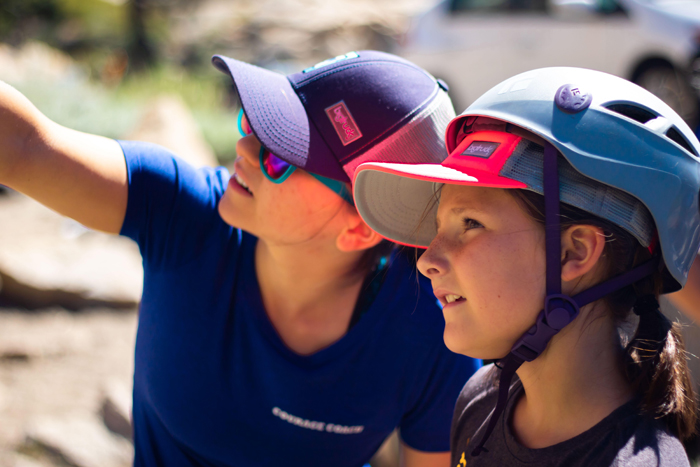- Tahoe’s Nevada Beach Tops the List of Hard-to-Book Campgrounds - 07/17/2024
- Cannabis Watershed Protection Program Cleans Up Illegal Grow Sites - 07/10/2024
- French Fire - 07/05/2024

Lance Hookano surfing his SUP.
Photo by Sander Nauenberg.
Imported from Hawaii, hybrid sport growing from Santa Cruz to Lake Tahoe
By Ramona d’Viola
In the blush of first light, on the island of Moloka’i, a conch shell bellows from the shores of Kaluako’i Beach. The kahuna has blessed the gathering of paddleboarders and their crews, bidding them good luck and a safe passage. The sound of his shell horn breathes life into the still morning. On cue, dozens of men, and a handful of women, charge into the surf for the annual Moloka’i to Oah’u Paddleboard Race. Their goal: To reach the southeast shore of Oah’u in as little time as possible.
The line-up features an impressive cast of international paddleboarders: the formidable Australians, the competitive Californians, and a smattering of super-fit European and Japanese watermen. Punctuating the string of prone paddlers are several hulking Hawai’ians — standing upright with paddles in hand — powering away toward the choppy channel, looking very much like the glyphs of their ancestors.
For the Honolulu beach boys who taught surfing at Waikiki’s waterfront, grabbing a paddle from a nearby outrigger made for easy trips to and from shore, especially with a sunburned tourist in tow. Now the accidental practice of stand-up paddleboarding (SUP), once rooted in convenience, has been improved upon by innovation, perfected in competition, and in the last few years blossomed into a bona-fide sport of its own.
Gaining Exposure
Witness the likes of über-surfer Laird Hamilton slaloming mountainous waves, carving perfect arcs with paddle in hand. And rock-star Sting, struggling along in calm Caribbean seas, proving it ain’t that easy. A stand-up paddleboard recently showed up in People magazine, of all places, on the shoulders of big-screen hunk Matthew McConaughey (BTW: I only look at the pictures – I don’t actually read the magazine).
Well, the media exposure was another spoonful of confirmation that this sport, once thought of as a fringe pursuit practiced mostly by aging surfers with troublesome backs, had crossed the foam line and was now riding a swell of pop-culture legitimacy – a development which more than likely would curl the toes of a few veterans, although it’s unlikely they would even notice.
Indeed, “stand-up” has become the latest surf-inspired offshoot to grab a following, and it appears poised to stay, as the reasons for its recent growth spurt go well beyond bare-chested celebrities. The practical, physical and sporting advantages of stand-up paddleboarding are numerous and compelling.
Broad Appeal
Dan Gavere was an early SUP adopter. A former pro whitewater kayaker, Gavere is a sales rep for Werner Paddles, a leading kayak and canoe paddle manufacturer that recently brought its expertise to the SUP market. The Hood River, Oregon-based road warrior credits the sports’ popularity to its increased visibility — on the water and in the press.
“With the continued cross-pollination between paddle sports and surfing, there’s more opportunities for people to access the ocean in a variety of mediums, whether there’s waves or not,” he says. “Stand-up paddling is another niche for the ever-evolving water sports market.”
As sales rep for the Southwest U.S. and Hawaii, Gavere is a frequent visitor to oceans sports epicenters like Santa Cruz, where he has seen a jump in his SUP sales at outlets like Kayak Connection, which sells the boards and offers rentals and classes.
Not everyone coming to stand-up paddleboarding is a surfer, nor do they want to be. According to Gavere, stand-up paddle surfing takes many of the negative aspects of traditional surfing out of the equation.
“You’re standing upright, you can see the waves from further out, you have the extra power a paddle provides, and you don’t have to jump to your feet … That prone to upright snap gets harder as you get older,” laughs Gavere.
There is great interest among a broad range of outdoor enthusiasts, says Kayak Connection owner Margeret Collins, including surfers, wind surfers, kayakers, and others that want to stay fit and in the outdoors.
“It is a great workout that keeps us outside and out of the gym,” says Collins, who enjoys getting out on the water in the morning. “It’s very meditative and very close to nature.”
Surf-bred, Not Surf Dependent
Saltwater isn’t the only province for SUPs. There are growing numbers on lakes and rivers, too. Laird Hamilton even paddled one down the Grand Canyon. On Lake Tahoe, SUPs are becoming a common sight and are sold in shops such as Tahoe Paddle & Oar in Kings Beach. There’s even a race on the lake each summer; the second-annual Ta-Hoe Nalu Stand-up Paddle Classic, a 7.4-mile race, takes place on Aug. 16 this year, www.ta-hoenalu.com.
“A great thing about the sport is that you don’t need the ocean,” says Duke Brouwer, marketing director for Surftech, the Santa Cruz-based board manufacturer. “Wherever there’s a body of water there’s an opportunity to stand on your board and go for a paddle. I’ve seen guys fishing off their SUPs on rivers … and recently heard of some guys planning a four-day stand-up paddle tour of Lake Powell with packs and sleeping bags.”
That’s why shops like Aquan Sports in San Carlos and California Canoe & Kayak in Oakland are finding SUPs to be a great new market – because they cross over from the surf to flatwater paddling on the bay and local lakes. Now surfers and paddlers in the Bay Area and elsewhere who can’t make it to the coast that often can get a great surf-style workout closer to home.
For kayak paddlers, stand-up paddling provides a fresh, heightened perspective when out on the water.
In San Diego, SUPs have become a popular cross-training tool for triathletes in its protected bays and along the coast. It makes for a phenomenal low-impact workout, Brouwer says. “It works not only your core muscles but engages all of your major muscle groups (to paddle and balance on the board).”
Another factor behind SUP’s surging popularity, Brouwer notes, is that the sport is very easy to learn – at least on flat water. “The boards are very stable and you can have the paddle wired after about a half an hour on the water.”
In the Sacramento area, SUP classes are offered through the summer at the Sacramento State Aquatic Center on Lake Natoma (916-278-2842; www.sacstateaquaticcenter.com). The introductory classes ($30 for the public) are three hours long; all equipment is provided. Check the website for dates and times.
Expert Swell Catchers
In surf and on the open ocean, SUPs can demand a considerably larger skill set than on flatwater. With their length and speed, stand-up paddleboards are ideal for catching ocean swells that don’t crest. Called “runners,” learning to ride these moving mounds of water is like hitching rides on a conveyor belt of hills.
The runners in the channel between Moloka’i and Oahu are legendary. The refraction waves generated by water slamming into land mass gives an experienced stand-up paddler a huge, albeit potentially dangerous, advantage. Several years ago, I watched Buzzy Kerbox rocketing along Oahu’s China Wall on his stand-up board, paddling into giant waves, and surfing them all the way into the bay. It was the first time I’d seen a stand-up paddler, and I was intrigued — if not awe struck.
“With the extra paddle power, you can get, and stay, in the pocket,” says Gavere. “Your paddle becomes a tiller, or gets hoisted overhead for surfing the hell out of a seemingly endless wave.”
SUP Full Disclosure
There can be some downsides to the sport, admits Gavere. “The extra gear, the cost of equipment, and unfortunately, localism. Not all surfers have embraced us.”
Provincial knuckleheads aside, enthusiasts are growing in number as paddleboarding, kayaking, and outrigger clubs see their ranks embracing a new sport. With categories showing up with increasing regularity at paddling competitions of all ilks, stand-up paddling might be the missing link among all camps.
“It’s one of the hardest workouts I’ve ever had,” says surfer, prone and stand-up, Tom Duryea. “It requires equal parts balance, power, agility, and endurance. But once you’re moving, it’s fast, really fast.”
Duryea, a familiar name in the winner’s circle at traditional belly-on-the-board paddleboarding competitions, has recently applied his impressive fitness to the stand-up variety of the sport. “I like to try any kind of watercraft, and stand-up paddling requires a whole new set of skills,” says Duryea, two-time winner of the Santa Cruz Paddleboard Union’s annual Jay Moriarity Memorial Paddleboard Race, and three-time Catalina Classic champion.
“You’re much more exposed to the wind and wake when you’re stand-up paddling, so balance is crucial. But, it allows for training with a more social aspect, in all types of conditions,” adds Duryea. “From flat and calm in the bay, to big and bumpy in ocean.”
Although stand-up paddleboards are versatile watercraft, if you’re interested in trying one, common sense and courtesy should hold sway – e.g. don’t paddle out into a crowded break, and don’t paddle into conditions beyond your ability. Remember, you’ve got a paddle and a whole lot more board to handle.
Aside from a few agro surfers, Gavere rates Santa Cruz as one of his favorite places to put in. “I caught a wave at Indicators and connected the dots all the way into Cowell’s,” says the lifelong waterman. “Santa Cruz is the perfect place for stand-up, whether you want to surf or just explore.”
One thing’s for sure: The rebirth of this ancient sport and its adoption in places so far in distance and climate from the islands would impress any kahuna.













